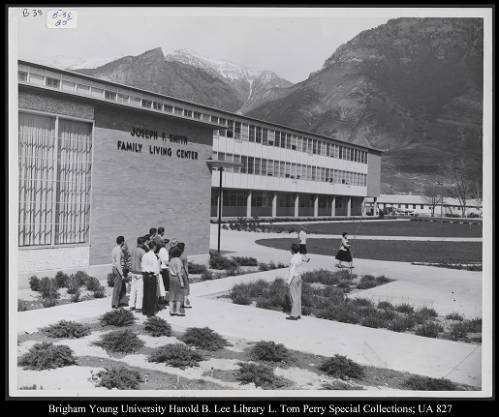Joseph F. Smith Family Living Center (SFLC)

The Joseph F. Smith Family Living Center was completed in 1957 as part of BYU’s effort to become a “leader in the field of family relations.” It housed the College of Family Home and Social Sciences until it was demolished in 2002.
The Joseph F. Smith Family Living Center was completed in 1957, the largest building on BYU’s campus at the time at 94,000 square feet and with 244 rooms. The Living Center was built to help BYU become a “leader in the field of family relations.” In the groundbreaking ceremony, architect Fred Markham said, “No other college or structure of this kind is known in a university today. Its concept lies in the LDS philosophy which recognizes the home and family as the heart of our earth life experience.”
In designing the building, architects hoped to provide space for both men and women, “based upon the fact that a man has an equal responsibility in the home with his wife.” It included an indoor-outdoor nursery, kitchens, sewing rooms, child observation facilities, telephone switchboards, and nursing facilities. It housed the College of Family Living, the School of Nursing, and the Departments of Sociology and Psychology.
The College of Family Living had been created in 1954 out of the College of Applied Science. It was organized to prepare students for “homemaking, professions related to homemaking, and to strengthen and enrich family life within their communities.” It included departments for Home Economics, Food and Nutrition, Human Development, Interior Design, Family Life Education, and other related subjects. The college was reestablished in 1981 as the College of Family, Home, and Social Sciences.
The building was named for Joseph F. Smith, former President of the Church of Jesus Christ of Latter-day Saints from 1901-1918. President Smith laid the foundations for the Church Education System by establishing the seminary program in 1912. During his time as President, the Church standardized courses of study in Church auxiliaries and added weekly lesson plans to Church magazines. President Smith had encouraged church members to focus on learning truths and said, “If you will learn the truth and walk in the light of truth you shall be made free from the errors of men.” He advised students to “search all things” but to “hold on only to that which is true.”
The building was eventually replaced by the Joseph F. Smith Building, which was completed in 2005. The new building is almost double the square footage of the old building and includes 27 classrooms and 401 faculty and administrative offices.
Images






